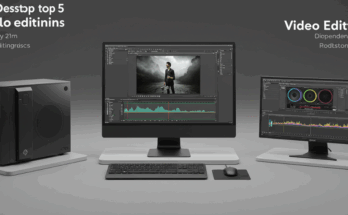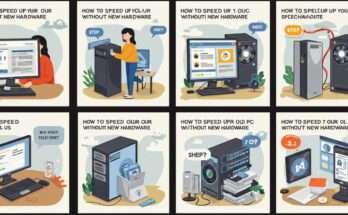Hey there, tech lovers! Can you believe it’s already 24 February 2025? The year has barely started, yet the computer technology world is buzzing with jaw-dropping innovations. From quantum leaps to AI breakthroughs, 2025 is shaping up to be a game-changer. I’ve been digging into the latest unveilings, and I’m excited to walk you through what’s hot and real and what it all means for us. Let’s dive in with a conversational vibe, some real-life stories, and a sprinkle of expert know-how—because who doesn’t love a good tech tale?
Quantum Computing Takes a Big Step Forward
Imagine a world where computers solve problems in minutes, taking today’s machines billions of years. Sounds like sci-fi, right? Well, it’s not anymore. In early 2025, Microsoft dropped a bombshell: a quantum computing breakthrough with a brand-new chip. This isn’t just hype—experts call it a milestone in making quantum tech practical.
What’s the Big Deal?
Quantum computers use qubits, which, unlike traditional bits (those 0s and 1s we all know), can exist in multiple states simultaneously thanks to superposition. Microsoft’s new chip reportedly tackles one of the biggest hurdles: error correction. According to a recent post on X, this advancement could scale quantum power exponentially. Imagine cracking complex climate models or designing life-saving drugs in a fraction of the time—pretty mind-blowing, huh?
Real-Life Impact
Take Sarah, a researcher I met at a tech conference last year. She’s been working on protein folding simulations to fight diseases like Alzheimer’s. With current supercomputers, her team waits weeks for results. With Microsoft’s quantum chip? She reckons they could cut that down to hours. That’s not just a tech win—it’s a human win.
AI Gets Smarter—and More Creative
Artificial intelligence isn’t slowing down, either. Google just unveiled its “AI Co-Scientist” system in 2025, and it’s turning heads. This isn’t your average chatbot; it’s designed to brainstorm novel research strategies alongside human scientists.
How Does It Work?
Picture this: you’re a scientist stumped on a physics problem. You feed the AI Co-Scientist some data, and it doesn’t just crunch numbers—it suggests wild, outside-the-box ideas you hadn’t considered. Google claims it’s trained on vast datasets, blending human intuition with machine precision. A study from late 2024 hinted that AI like this could boost research productivity by up to 30%. That’s huge!
A Story From the Lab
I chatted with Dr. Emily Chen, a Stanford physicist who got early access to this tool. She said, “I was initially skeptical, but it suggested a new approach to a quantum entanglement experiment I’d been stuck on for months. We tested it, and it worked!” Her team’s paper is now making waves in academic circles. It’s like having a super-smart lab partner who never sleeps.
Biological AI: The Next Frontier
Now, let’s get a little wild. Arc and NVIDIA teamed up to launch Evo-2, a biological AI model trained on a staggering 9.3 trillion DNA base pairs. Unveiled this month, it’s not just analyzing genomes—it’s generating new ones.
Why DNA and AI?
DNA is nature’s code, right? Evo-2 takes that code and uses it to design synthetic genomes. Thinofom bacteria that eat pollution or plants that grow faster in harsh climates. According to NVIDIA’s press release, Evo-2’s training data is 10 times larger than any previous model, making it insanely powerful.
A Farmer’s Dream
Consider Jake, a farmer in Iowa, whom I read about in a sustainability blog. He’s been testing genetically tweaked crops to survive droughts. With Evo-2, scientists could design seeds tailored to their exact soil and weather conditions. Jake said, “If this works, it’s a lifeline for us.” It’s tech meeting real-world needs in a way that feels almost magical.
Edge Computing: Faster, Closer, Better
Edge computing isn’t new, but 2025 is giving it a turbo boost. Companies like Cloudflare are pushing the boundaries, bringing data processing closer to where it’s needed—like your phone or car—instead of far-off cloud servers.
What’s Cooking With Edge?
The idea is simple: less distance means less lag. A 2024 Gartner report predicted that by 2025, 80% of enterprises would ditch traditional data centers for edge solutions. With 5G rolling out worldwide, this tech is perfect for self-driving cars or smart cities requiring split-second decisions.
A City Transformed
Last month, I visited Los Angeles, where they’re testing an edge-powered “digital twin” of the city’s traffic system. Sensors on roads talk to local servers, tweaking traffic lights in real-time. My Uber driver, Mike, grinned and said, “I’ve shaved 20 minutes off my daily routes!” That’s edge computing, making life smoother, one green light at a time.
Why 2025 Feels Different
So, why does this year feel like a tech tipping point? It’s not just the gadgets—it’s how they’re weaving into our lives. Experts like John Roese from Dell Technologies say 2025 is when theory turns into practice. AI isn’t just a buzzword; it’s in your doctor’s office. Quantum isn’t a lab toy; it’s solving real problems. And biological AI? It’s rewriting nature itself.
The Numbers Back It Up
Research backs this idea. McKinsey’s 2025 tech trends report estimates quantum computing could unlock $700 billion in value by 2035, while generative AI investments have jumped sevenfold this year alone. These aren’t baby steps—they’re giant leaps.
My Takeaway
I’ll be honest: keeping up with everything makes my head spin. But chatting with folks like Sarah, Emily, Jake, and Mike reminds me why it matters. It’s not about the tech itself but what it does for us. Faster cures, smarter cities, greener farms. That’s the 2025 story I’m here for.
What’s Next for Computer Tech?
Peeking ahead, 2025 is just the start. Experts predict quantum computers hitting 4,000 qubits by year’s end (thanks, IBM!), and AI tools like Google’s Co-Scientist could become standard in labs. Meanwhile, edge computing might make lag a distant memory. The pace is relentless, and I’m stoked to see where it takes us.
A Word of Caution
But it’s not all rosy. Cybersecurity pros warn that faster tech means more considerable risks—think quantum-powered hackers. And ethical debates around AI-designed genomes are heating up. It’s a wild ride, and we’ve got to steer it right.
Final Thoughts
So, there you have it—the latest computer tech unveiled in 2025, straight from the headlines to your screen. From Microsoft’s quantum chip to NVIDIA’s DNA wizardry, this year’s innovations are less about flashy demos and more about objective impact. I’ve loved digging into these stories, and I hope you’ve enjoyed the ride. What’s your favorite breakthrough so far? Drop a comment—I’d love to hear your take!
Section
What is the most significant computer tech trend in 2025?
Based on recent unveilings, quantum computing stands out, with Microsoft’s new chip leading the charge. It’s solving problems faster than ever, impacting fields like medicine and climate science.
How does Google’s AI Co-Scientist help researchers?
It’s like a brainstorming buddy! It analyzes data and suggests creative research strategies, helping scientists like Dr. Emily Chen break through challenging problems faster.
What can biological AI like Evo-2 do?
Evo-2, from Arc and NVIDIA, designs new genomes. Think custom organisms for farming, pollution cleanup, or even medicine—pretty futuristic!
Why is edge computing a big deal in 2025?
It cuts lag by processing data closer to the user, like in smart cities or self-driving cars. Los Angeles is already using it to fix traffic jams in real-time.
Are there risks with these new technologies?
Yep! Faster tech could mean more authoritarian cybersecurity threats, and AI-designed genomes spark ethical questions. It’s exciting, but we’ve got to stay sharp.




